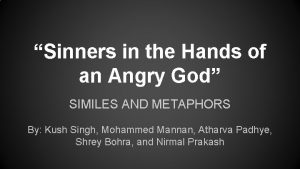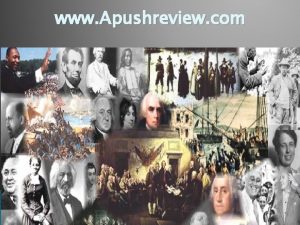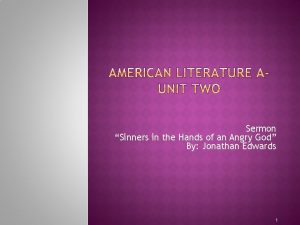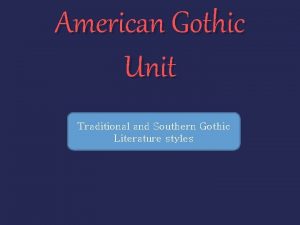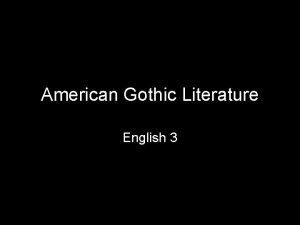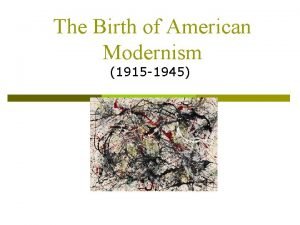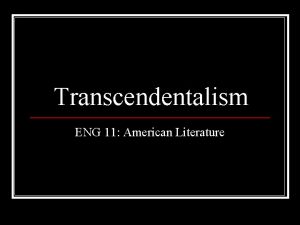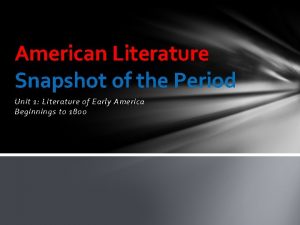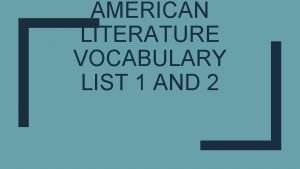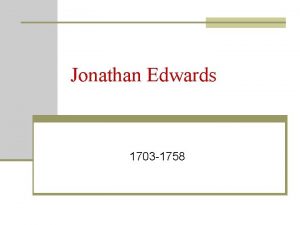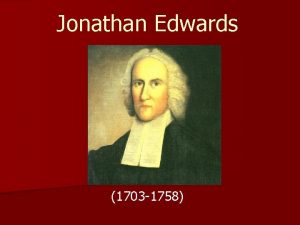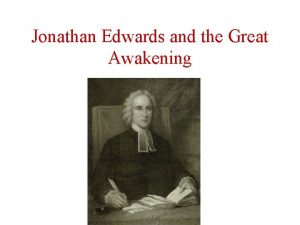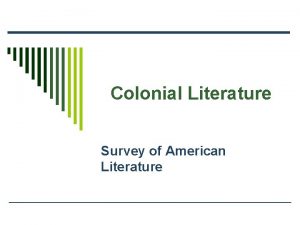Jonathan Edwards 1703 1758 American Literature I 10













![Salem Witchcraft Trials (2) l l It has been suggested [Boyer and Nissenbaum] that Salem Witchcraft Trials (2) l l It has been suggested [Boyer and Nissenbaum] that](https://slidetodoc.com/presentation_image_h2/eec133fe7d80659b3ba8175397eac294/image-14.jpg)



- Slides: 17

Jonathan Edwards 1703 -1758 American Literature I 10 /18/2004 Cecilia H. C. Liu

Historical Background (1) l l During last decades of the 17 th century, many Puritans felt that society had betrayed the first settlers' hopes of building the New Jerusalem in America. The 1660 Restoration of Charles II to the English throne was the first of many blows. The church had also undergone key changes. For example, in 1662 a synod of Boston theologians met and adopted the "Halfway Covenant, " which extended the sacrament of baptism to the children of those who had not experienced religious conversion.

Historical Background (2) l l The real purpose of this compromise: to solve the problem of declining church membership. New England society also underwent enormous changes after 1660. The success of Boston as a commercial hub brought great changes: new richness in habits of dress, entertainment, and the adornment of homes and public buildings; as well as boomtimes for tavern-keepers, brothel operators, and the owners of horse-tracks.

New England Politics l Politics in New England was permanently altered in 1691 when the crown acted to revoke the 1630 charter of the Massachusetts Bay Company, put the colony under royal governorship, united the formerly distinct Plymouth colony with the Bay Company, and entitled all Christians (except Catholics) to vote. In a trice, Massachusetts had been changed from a theocracy into a secular (and proto-democratic) colony. Meantime, from Europe came news of new, rationalistic philosophical thinking--in names like Rene Descartes (1596 -1650), Isaac Newton (16431727) and John Locke (1632 -1704)--which posed strong challenges to Puritan doctrines of predestination and election.

Salem Witchcraft Trials l The 1692 witchcraft trials in Salem, Massachusetts, may be seen as an outgrowth of these anxious times. Many historians see them as a last-ditch attempt of churchmen to assert their authority over an increasingly secular society. As a chronicler of those events, Cotton Mather revealed the backwards-looking side of his character.

Cotton Mather l l As the title of his Wonders of the Invisible World implies, Mather believed there was a realm of supernatural beings, claimed to have experienced a visit from an angel when he was thirty, and wrote of confronting devils as well, saying on one occasion that he had physically prevented a devil from wrapping invisible manacles around a girl. The forwards-looking side of Mather's character is revealed in other writings, perhaps best of all his 1710 book Bonifacius, which was popularly known under the title of Essays to Do Good, and an enormous influence on the young Benjamin Franklin.

Cotton Mather’s Arguments l In these writings, Mather argued for the pragmatic benefits of religion, and put to use the humanistic ideas of early Enlightenment thinkers. Mather's writings on geology, astronomy and botany won him a wide reputation; and with Boston physician Zabdiel Boylston he brought to America the practice of inoculating people against smallpox.

Edward’s Beliefs (1) l l l Broadly educated, having read extensively in the philosophy of Descartes, Locke and others Edwards absorbed much from rationalist science, in particular the idea of Man as a natural organism conditioned by its environment. Edwards also realized that Locke's ideas of a human psyche based on physical sensation, in a cosmos ruled by mechanistic laws, had rendered obsolete much of conventional theology-especially its ideas of a separate spiritual realm, Mather's "invisible world. "

Edward’s Beliefs (2) Edwards himself was to be the instrument of New England's reformation in the 1730 s and '40 s. l He insisted there would be times of conflict, remissions and lulls between the sovereign outpourings of the Spirit. l

Edward’s Writings l l l The challenge Edwards faced was to sustain basic tenets of Puritan belief--original sin, predestination, and providence--against this increasingly secular climate. His writing in Images and Shadows of Divine Things illustrates the attempt to blend a rationalist observation of nature with his Puritanism. His "Personal Narrative"--a spiritual autobiography in the tradition of Bradstreet's--reveals a man struggling with the rationalist challenge to religious belief.

Edwards and the "Great Awakening” l Edwards is best remembered for his contributions to the "Great Awakening" of the 1740's, when much of New England was swept by a revivalist fervor. Edwards's sermon, "Sinners in the Hands of an Angry God, " is a classic instance of the hell-fire and brimstone preaching which apparently typified the Great Awakening. It stands, moreover, as a final, classic statement of Puritan belief in a colonial society becoming increasingly rationalistic, economically and politically independent, and conscious of itself as American--the society, in short, of Franklin, Jefferson, Paine and Crevecoeur.

Questions for Discussion l Edwards' 1741 sermon, "Sinners in the Hands of an Angry God, " seems to be based upon a scriptural text from Deuteronomy ("Their foot shall slide in due time"). In fact, however, Edwards' text really proceeds through an act of paraphrase or interpretation, as he restates the scripture for his own use. What is his restatement of it, and how does he then use that restatement? l According to Edwards, what are the main features of God's punishment against sinners?

Salem Witchcraft Trials (1) l l l Although the accusations of witchcraft at Salem described by Cotton Mather in The Wonders of the Invisible World have become the most notorious example of the hysteria about witches. According Paul Boyer and Stephen Nissenbaum's account, the outbreak at Salem began in the winter of 1691 when the girls of the village, aided by Tituba and John Indian, a West Indian slave couple, attempted to tell their futures by using a makeshift crystal ball. On February 29, 1692, warrants were issued for three women: Sarah Good, Sarah Osborne, and Tituba, the former two proclaiming their innocence while the latter confessed.
![Salem Witchcraft Trials 2 l l It has been suggested Boyer and Nissenbaum that Salem Witchcraft Trials (2) l l It has been suggested [Boyer and Nissenbaum] that](https://slidetodoc.com/presentation_image_h2/eec133fe7d80659b3ba8175397eac294/image-14.jpg)
Salem Witchcraft Trials (2) l l It has been suggested [Boyer and Nissenbaum] that what happened at Salem was the outgrowth of conflicts between the rising mercantile class and the people who were tied to the wealth and power of the merchants. In addition to sexual and doctrinal threat posed by independent women, those with property and no male heirs constituted a threat to an economic system based on the "orderly transfer of property from father to son. "

Map of Salem Village

Cotton Mather’s Beliefs l l Cotton Mather remains one of the most famous religious figures from the early New England Puritan society. Cotton Mather was a true believer in witchcraft. In 1688, he had investigated the strange behavior of four children of a Boston mason named John Goodwin. His sermons and written works fanned the flames of the witchcraft hysteria. He declared that the Devil was at work in Salem, and that witches should face the harshest punishment. He became a major influence during the Salem witch trials, during which many people, were hanged. Later on, when confessed witches began denying their testimony, Mather may have begun to have doubts about at least some of the trials. He revised his own position on the use of spectral evidence and tried to minimize his own large role in its consideration in the Salem trials.

References l Great Awakening • http: //home. earthlink. net/~gfeldmeth/lec. ga. html http: //www. wfu. edu/~matthetl/perspectives/four. html • http: //www. nhc. rtp. nc. us/tserve/eighteen/ekeyinfo/grawaken. htm • http: //www. u-s-history. com/pages/h 620. html http: //library. sebts. edu/sprescott/Church%20 History_files/ Great%20 Awakening. htm • • l Models for Reformation: Jonathan Edwards, The First Great Awakening l Salem Witchcraft
 Scapula bone chicken
Scapula bone chicken Sinners in the hands of an angry god metaphor
Sinners in the hands of an angry god metaphor Jonathan edwards a puritan code worksheet answers
Jonathan edwards a puritan code worksheet answers Jonathan
Jonathan Auditory imagery definition
Auditory imagery definition Korematsu vs us apush definition
Korematsu vs us apush definition Jonathan david edwards
Jonathan david edwards According to jonathan edwards sermon what is a constant
According to jonathan edwards sermon what is a constant American gothic movement
American gothic movement American gothic literature definition
American gothic literature definition American modernism characteristics
American modernism characteristics What is a transcendentalist
What is a transcendentalist Workinsme
Workinsme Young goodman brown dark romanticism
Young goodman brown dark romanticism American literature unit 1
American literature unit 1 American gothic literature definition
American gothic literature definition Realism and naturalism in literature
Realism and naturalism in literature Literature vocabulary words
Literature vocabulary words

